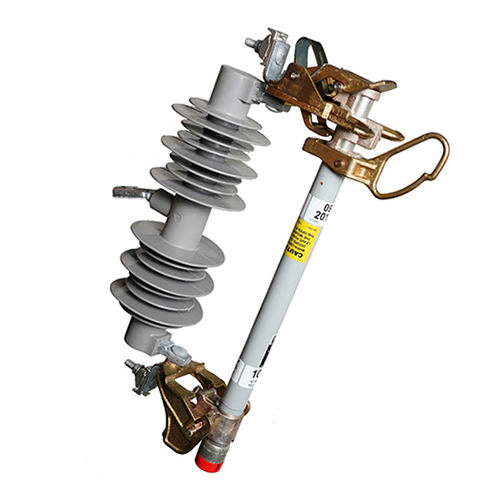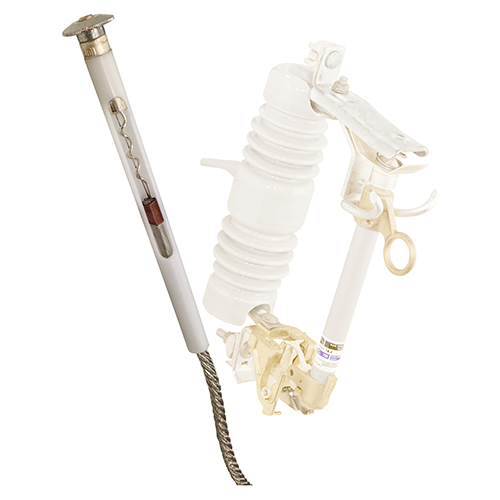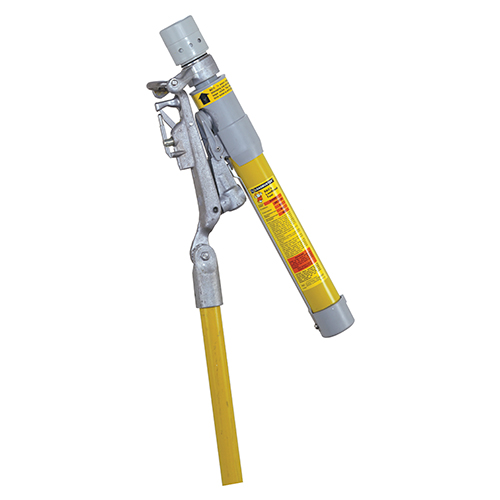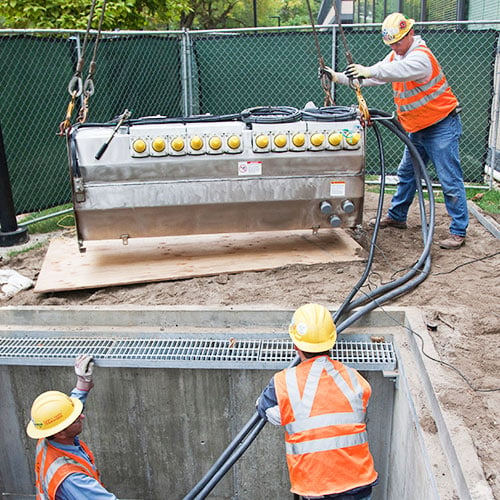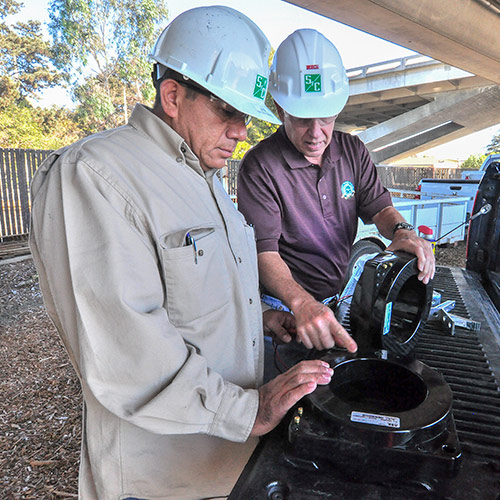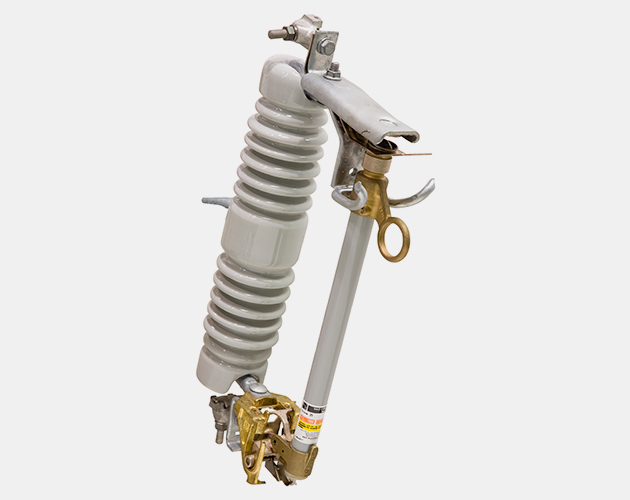
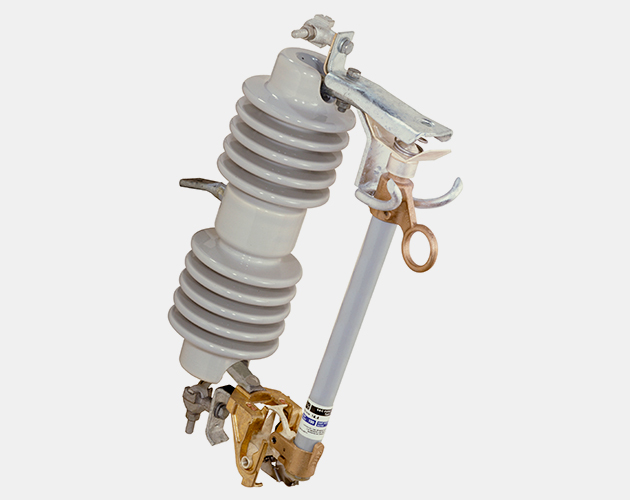
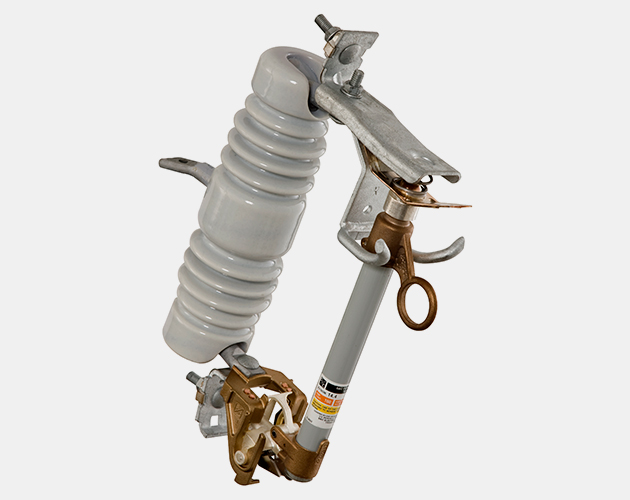
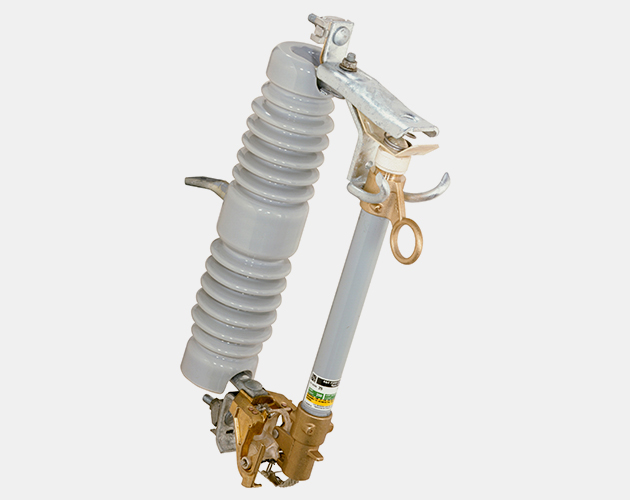
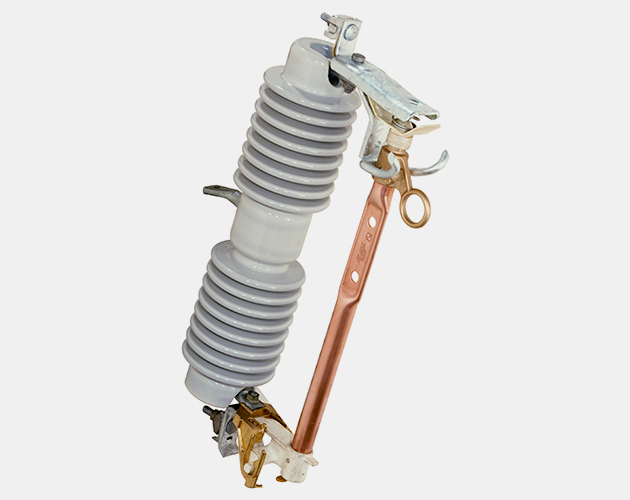
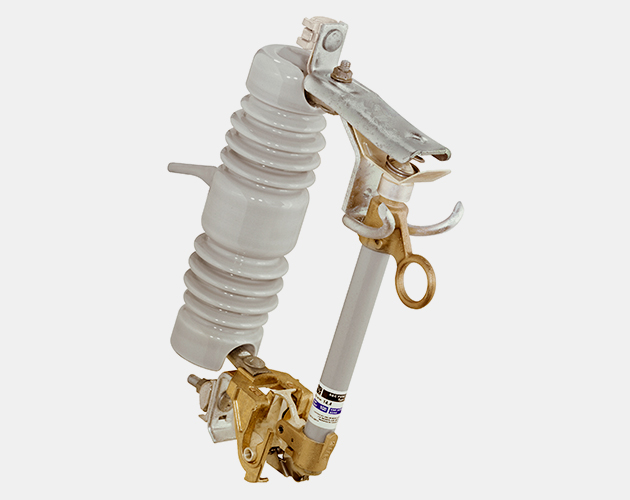
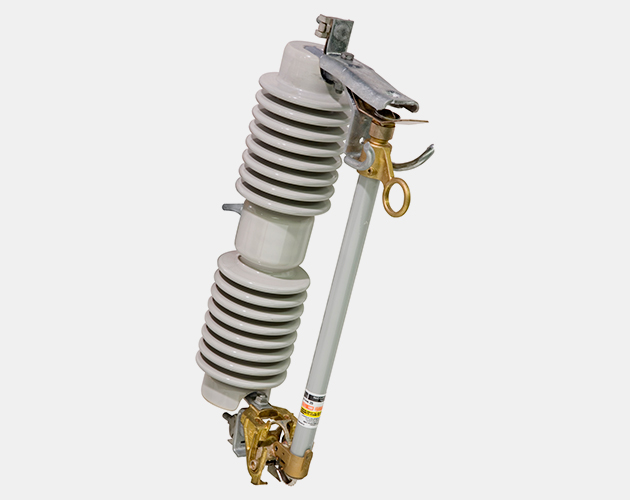
Type XS Fuse Cutout
For outdoor distribution, 4.16 kV through 25 kV
When fused with S&C Positrol® Fuse Links, S&C Type XS Fuse Cutouts provide full-fault-spectrum protection to overhead distribution systems
S&C Type XS Fuse Cutouts, when fused with S&C Positrol® Fuse Links, provide full-fault-spectrum protection for overhead distribution systems rated 4.16 kV through 25 kV, whether applied on overhead transformers, capacitors, cables or lines.
This performance also extends to solidly grounded systems rated 26.4 kV through 34.5 kV, for protection of single-phase-to-neutral lines and transformers and grounded-wye-connected capacitor banks. “Full-fault-spectrum protection” means that Type XS Fuse Cutouts will interrupt all faults — from the lowest current that will melt the fuse link to the maximum rated interrupting current — under all realistic transient-recovery-voltage conditions.
S&C’s Type XS Fuse Cutouts are manufactured in accordance with a quality system certified to ISO9001:2000.
All Type XS Fuse Cutouts employ an S&C-developed innovation — single venting, down and away only — an especially important feature where exhaust must be kept out of other phases in overbuilt circuits. There are no costly-to-replace expendable fuse-tube caps.
Type XS Fuse Cutouts provide superior mechanical handling and electrical performance, including:
- Easy fuse link installation — even with gloved hands
- Easy fuse tube insertion (and removal)
- Superb alignment when closing — from any angle and under adverse conditions of light and weather
- No fuse link breakage
- Completely reliable dropout action — regardless of fault-current level
- Mates perfectly with S&C’s Loadbuster® Tool — for sure, reliable load switching
Single-Shot Overhead — Pole-Top Style Type XS Fuse Cutouts are sold in the U.S. and Canada by MacLean Power Systems. For additional information, please visit their website at www.macleanpower.com.
(On mobile, swipe left for remaining ratings information.)
| kV | Amperes, RMS | Leakage Distance to Ground, Minimum |
|||||
|---|---|---|---|---|---|---|---|
| Nom. | Max | BIL | Cont. | Interr., Asym. | Inches | mm | |
| 60 Hz | 50 Hz | ||||||
| 14.4 | 15 | 110 | 100 | 10 000 | 8 000 | 8-1/2 | 216 |
| 16 000 | 12 800 | 8-1/2 | 216 | ||||
| 200 | 12 000 | 9 600 | 8-1/2 | 216 | |||
| Disconnect 300 |
— | — | 8-1/2 | 216 | |||
| 25 | 27 | 125 | 100 | 8 000 | 6 400 | 11 | 279 |
| 12 000 | 9 600 | 11 | 279 | ||||
| 200 | 10 000 | 8 000 | 11 | 279 | |||
| Disconnect 300 |
— | — | 11 | 279 | |||
| 150 | 100 | 8 000 | 6 400 | 17 | 432 | ||
| 12 000 | 9 600 | 17 | 432 | ||||
| 12 000 | 9 600 | 26 | 660 | ||||
| 200 | 10 000 | 8 000 | 17 | 432 | |||
| Disconnect 300 |
— | — | 17 | 432 | |||
| — | — | 26 | 660 | ||||
S&C Electric Company does not sell Type XS Fuse Cutouts in the United States, Canada, and the Caribbean (excluding countries located on the mainland of Central America and South America).
Operation with Loadbuster, S&C’s Portable Loadbreak Tool:
Attach.
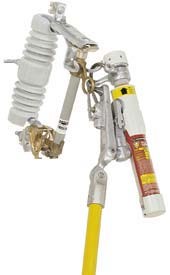
Reach across the front of the cutout and attach Loadbuster’s anchor to the attachment hook on the far side of the cutout, and then engage its pull ring with Loadbuster’s pull-ring hook. Loadbuster’s pull-ring latch prevents inadvertent disengagement of the cutout pull ring and Loadbuster’s pull-ring hook.
Pull.
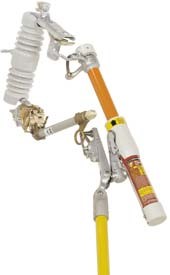
A firm, steady downward pull on Loadbuster — to its maximum extended length — opens the cutout in the normal manner as the current is diverted through Loadbuster. At a predetermined point in the opening stroke, Loadbuster trips, breaking the circuit positively.
Remove.
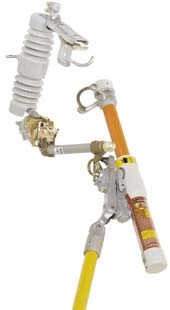
Loadbuster is disengaged by first removing its anchor from the cutout attachment hook. Then, with the blade in the open position, Loadbuster is removed from the pull ring with a simple “roll-off” motion.
Single-Shot Overhead — Pole-Top Style Type XS Fuse Cutouts are sold in the U.S. and Canada by MacLean Power Systems. For additional information, please visit their website at www.macleanpower.com.
Extra-Heavy-Duty Styles
89021R10
14.4 kV nominal
15 kV maximum
110 kV BIL
100 amperes continuous
10,000 amperes interrupting RMS asymmetrical at 60 Hz

89022R10
25 kV nominal
27 kV maximum
125 kV BIL
100 amperes continuous
8,000 amperes interrupting RMS asymmetrical at 60 Hz
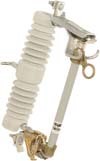
89042R10
25 kV nominal
27 kV maximum
150 kV BIL
100 amperes continuous
8,000 amperes interrupting RMS asymmetrical at 60 Hz
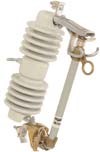
Disconnect, Overhead — Pole-Top Styles
89222R10
25 kV nominal
27 kV maximum
125 kV BIL
300 amperes continuous
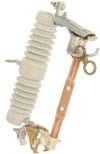
Ultra-Heavy-Duty Overhead — Pole-Top Styles
89031R10
14.4 kV nominal
15 kV maximum
110 kV BIL
100 amperes continuous
16,000 amperes interrupting RMS asymmetrical at 60 Hz

89032R10
25 kV nominal
27 kV maximum
125 kV BIL
100 amperes continuous
12,000 amperes interrupting RMS asymmetrical at 60 Hz

89052R10
25 kV nominal
27 kV maximum
150 kV BIL
100 amperes continuous
12,000 amperes interrupting RMS asymmetrical at 60 Hz
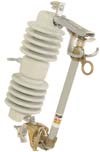
89053R10
25 kV nominal
27 kV maximum
150 kV BIL
100 amperes continuous
12,000 amperes interrupting RMS asymmetrical at 60 Hz
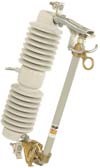
S&C Electric Company does not sell Type XS Fuse Cutouts in the United States, Canada, and the Caribbean (excluding countries located on the mainland of Central America and South America).
| Curve Type | Ampere Ratings | Fuse Type | TCC Number | Excel | |
|---|---|---|---|---|---|
| Minimum Melting | All | Fuse Link | TCC Number 123-6 | EXCEL | |
| Total Clearing | 1 through 200 | Fuse Link | TCC Number 123-6-2 | EXCEL |
| Curve Type | Ampere Ratings | Fuse Type | TCC Number | Excel | |
|---|---|---|---|---|---|
| Minimum Melting | All | Fuse Link | TCC Number 165-6 | EXCEL | |
| Total Clearing | 6K through 200K | Fuse Link | TCC Number 165-6-2 | EXCEL |
| Curve Type | Ampere Ratings | Fuse Type | TCC Number | Excel | |
|---|---|---|---|---|---|
| Minimum Melting | All | Fuse Link | TCC Number 170-6 | EXCEL | |
| Total Clearing | 6T through 200T | Fuse Link | TCC Number 170-6-2 | EXCEL |
| Curve Type | Ampere Ratings | Fuse Type | TCC Number | Excel | |
|---|---|---|---|---|---|
| Minimum Melting | All | Fuse Link | TCC Number 171-6 | EXCEL | |
| Total Clearing | 3KSR through 200KSR | Fuse Link | TCC Number 171-6-2 | EXCEL |
No longer available; TCC data for reference only.
| Curve Type | Ampere Ratings | Fuse Type | TCC Number | Excel | |
|---|---|---|---|---|---|
| Minimum Melting | All | Fuse Link | TCC Number 166-6 | EXCEL | |
| Total Clearing | 1QR through 200QR | Fuse Link | TCC Number 166-6-2 | EXCEL |
| Curve Type | Ampere Ratings | Fuse Type | TCC Number | Excel | |
|---|---|---|---|---|---|
| Minimum Melting | All | Fuse Link | TCC Number 175-6 | EXCEL | |
| Total Clearing | 3DR through 20DR | Fuse Link | TCC Number 175-6-2 | EXCEL |
![]() No longer available; TCC data for reference only.
No longer available; TCC data for reference only.
| Curve Type | Ampere Ratings | Fuse Type | TCC Number | Excel | |
|---|---|---|---|---|---|
| Minimum Melting | All | Fuse Link | TCC Number 167-6 | EXCEL | |
| Total Clearing | 5N through 200N | Fuse Link | TCC Number 167-6-2 | EXCEL |
| Curve Type | Ampere Ratings | Fuse Type | TCC Number | Excel | |
|---|---|---|---|---|---|
| Minimum Melting | All | Fuse Link | TCC Number 172-6 | EXCEL | |
| Total Clearing | 101, 102, 103 | Fuse Link | TCC Number 172-6-2 | EXCEL |
